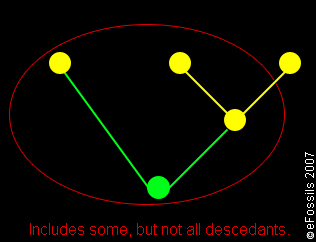the study of the fossil record of human evolution.
an epoch in the Cenozoic era on the geologic time scale that approximately dates from 65 million years ago to 24 million years ago; marked by the first appearance of horses, whales and many rodents in the fossil record. The Paleocene is the first epoch of the Tertiary period.
[Greek: "Old Stone Age"] the period of time that dates from the beginnings of stone tool manufacture and use at about 2.5 million years ago, and divided into three subgroup: Lower Paleolithic, Middle Paleolithic, and Upper Paleolithic.
[Greek: "early life"] a geological era that approximately dates from 540 million years ago to 245 million years ago; contains the geologic periods Permian, Carboniferous (i.e., Pennsylvanian and Mississippian), Devonian, Silurian, Ordovician and Cambrian.
["the robust australopiths"] a form of extinct hominins, possibly ancestral to human, that approximately dates from 2.5 million years ago to 700,000 years ago; fossil paranthropines show evidence of bipedalism and retain relatively small brains. Paranthropines differ from australopithecines in that they have a robust stature, a pronounced sagittal crest, relatively larger cranial capacity, and immense mandibles. The genus Paranthropus includes the species Paranthropus aethiopicus, Paranthropus boisei and Paranthropus robustus.

in cladistics, a clade (i.e., group) that consists of a single common ancestor and some, but not all, of its descendants.
an interval of geologic time shorter than an era and longer than an epoch.
[Greek: "visible life"] an eon that approximately dates from 545 million years ago and the present; marked as the time of living organisms; contains the Paleozoic, Mesozoic and Cenozoic eras.
observable physical properties of an organism resulting from genes and the affects of the environment.
an evolutionary lineage.
the study of humans and the other primates from a biological and evolutionary perspective.
flexion of the foot toward the ground or distally. The foot is plantarflexed when you stand on the tips of your toes.
an epoch in the Cenozic era on the geologic time scale that approximately dates from 1.8 million years ago to 10,000 years ago; marked by the evolution of modern Homo sapiens and giant land mammals. The Pleistocene is the first epoch of the Quaternary period.
a primitive trait.
an epoch in the Cenozoic era on the geologic time scale that approximately dates from 5.3 million years ago to 1.8 million years ago; marked as the period of human evolution after the split from the ape lineage. The Pliocene is the last epoch of the Tertiary period.
the entire repertoire of positions that an animal engages in, including movement or locomotion (i.e., leaping, walking, climbing, brachiation, etc.), and positions at rest or posture (sitting, standing, hanging, feeding, sleeping, etc.).
the narrowing bony portion behind the orbits of the skull; produced by a combination of having a large face and a small brain and sometimes large temporalis muscles.
in taxonomic classifications, a mammalian order that includes prosimians, monkeys, apes, and humans.
the study of primates.
a trait that is present in the ancestral form.
forward projection of the jaws beyond the rest of the face.
rotary motion that moves the thumb from the lateral to the medial position; the opposite of supination.
[Greek: "before life"] an era on the geologic time scale that approximately dates from 2.5 billion years ago to 540 million years ago; marked by the formation and breakup of Rodinia and the evolution of the first metazoans; contains the Vendian or Ediacaran periods.
a relative term used to describe a part of a limb that is closer to the attachment point to the trunk of the body; the opposite of distal.
eFossils is a collaborative website in which users can explore important fossil localities and browse the fossil digital library. If you have any problems using this site or have any other questions, please feel free to contact us.
Funding for eFossils was provided by the Longhorn Innovation Fund for Technology (LIFT) Award from the Research & Educational Technology Committee (R&E) of the IT governance structure at The University of Texas at Austin.
